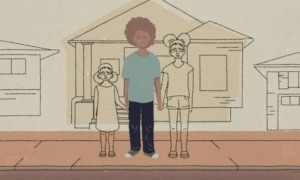This article is republished from The Conversation under a Creative Commons license.
Black youth show up in emergency rooms with gunshot wounds or other violent injuries at an alarming and disproportionate rate in the United States. Some hospitals have violence interventions that can be effective in keeping these kids safer after they are treated, but in most cases victims are sent back into the world to continue their struggles.
What if there were a way to prevent these kids from ending up in that hospital room in the first place? What if, years earlier, we could identify factors that predict which children are most likely to head down paths to violence?
I’m a social scientist focused on this question, and my research has led me to an answer that I believe is at once obvious and profound: Find these children early in public schools and help them then and there.
The study I led provides evidence that kids who grow up in poverty – or who are referred to child protective services – are significantly more likely to become victims of violence when they become teenagers.
A unique study with unusual access to information
To do our study, my team looked at records for 429 Black youths who had been sent to the ER for gunshot wounds or injuries from severe assaults over a one-year period. They included hospital, child protective service and juvenile court records, among others.
This was made possible because the Center on Urban Poverty and Community Development at Case Western Reserve University keeps troves of identifiable records on each of the 700,000 children who live in Cleveland. The records include information from more than 30 administrative agencies.
This rare resource allowed us to follow the life path of these young people from birth all the way to their arrival at emergency rooms with their injuries. The children ranged in age from 5 to 16 but averaged about 12.
We compared this study group with a control group of 5,000 youths who were not victims of gunfire or assault in that year but who grew up in the same neighborhoods and were similar in race, age and gender as the injured group.
As a result, we built a sophisticated picture of the childhood experiences that lead to violent injuries for low-income Black youths. Our objective was to find points of potential intervention.
Juvenile delinquency is not the most important predictor
Two factors that figure prominently in the backgrounds of violently injured youth are kids who have had interactions with both the juvenile court and child protection systems. Studies have shown they are at the highest risk of eventually suffering a violent injury, so a large portion of public resources go to addressing these children. In our study, victims of violence were four times more likely to be involved with juvenile court than noninjured youth in the control group.
Yet kids who endured both factors are also a minority of the youths in our study who were violently injured. In fact, 75% of violently injured youths fell into two other groups. One was those who attend public school and had received public assistance in early life. The other was those who attended public school and had been involved in the child welfare system before they were 5.
[Related: Breaking walls, building bridges — A call for restorative justice in school discipline]
Kids and teens in our study who ended up in the emergency room by age 13 as victims of violence were nearly three times more likely have been in foster care by age 4 compared to noninjured kids in our control group. Likewise, injured kids were twice as likely to have lived in a homeless shelter by age 7. And violently injured kids were chronically absent from school at rates 1.5 times higher than non-injured kids.
That is an important revelation. It shows that poverty and domestic problems loom larger than interactions with juvenile courts in foretelling eventual violent injury.
Public schools are the common denominator
School is where we can identify these children in their high-risk groups. To be clear, going to public school is not itself a risk factor; it’s just an opportune situation to help them. It’s an ideal place because it is both a compulsory and, ideally, a nonthreatening environment.
Still, there are important barriers to doing this effectively. In the best-case scenario, public schools could provide special attention to students whose families have been on public assistance or investigated by child protective services as early as age 5. But to do so, they – or whichever agency is in a position to help – would need information from individual records that are often private and unavailable.
[Related: What happens when suspensions get suspended?]
In Cleveland, much of this information is being integrated by Case Western and available to us as researchers on grounds we do not divulge details that could identify a specific child or family. Child protection services records in particular are almost always confidential and unavailable to anyone not directly involved in a particular case without a court order.
What can be done
Those privacy safeguards are important but not insurmountable. At least one community, Allegheny County in Pennsylvania, has found a way to identify families in need that has proven effective.
Communities that don’t have access to integrated data like Allegheny’s model can instead use school screening questionnaires that strike a balance between getting information and permitting families a level of privacy about what they share.
These youths are reachable long before they show up in the ER. Our research tells us where to find them.
***![]()
Laura Voith, is an associate professor of applied social sciences at Case Western Reserve University. Dr. Voith has worked over the last decade to address violence against women and youth through counseling, agency- and community-based coordination efforts, and research. Her research focuses on the prevention and intervention of violence against women by working with boys and men to uncover the etiology of violence though the lens of trauma and health disparities.
This article is republished from The Conversation under a Creative Commons license. Read the original article.





























